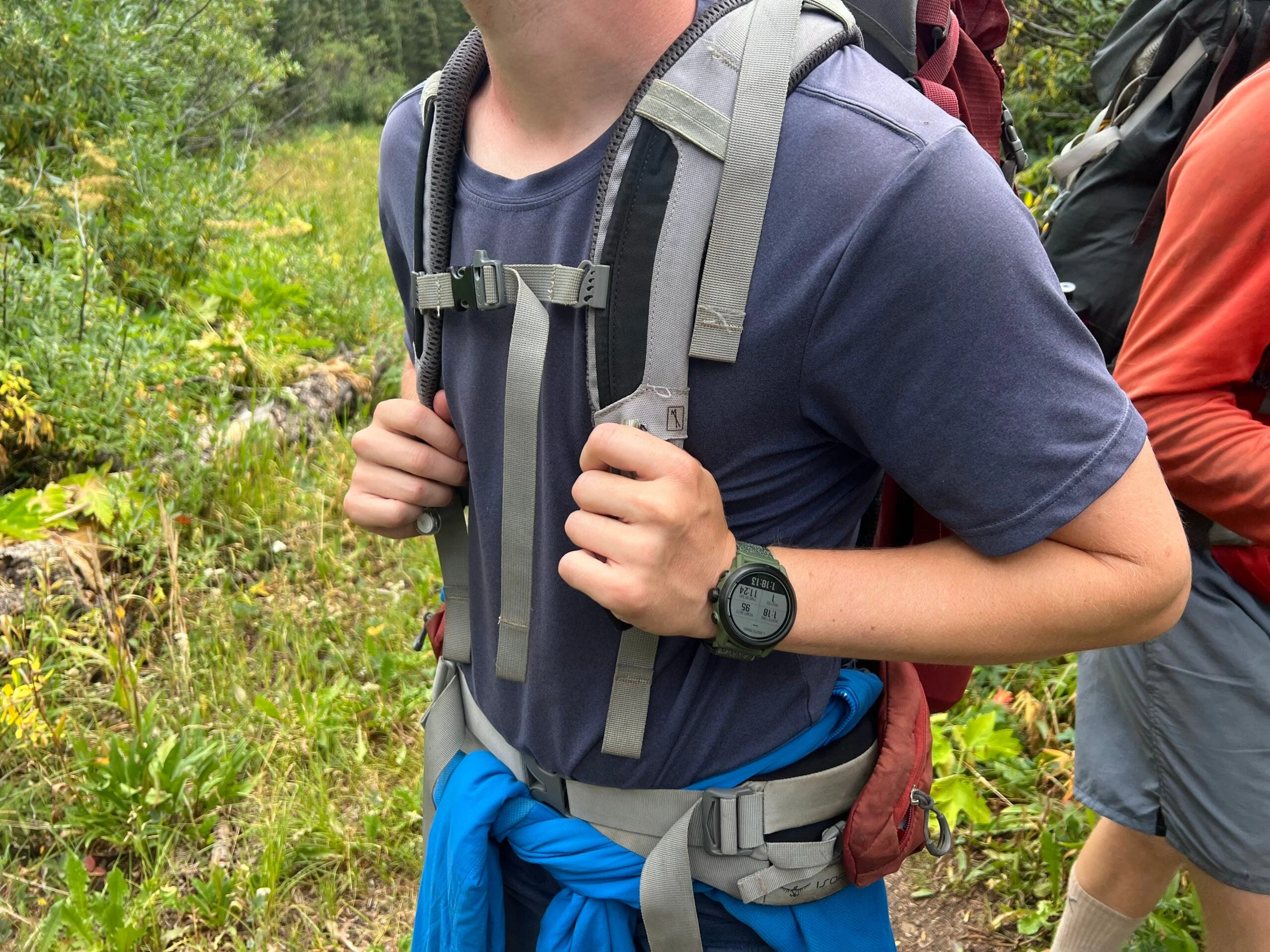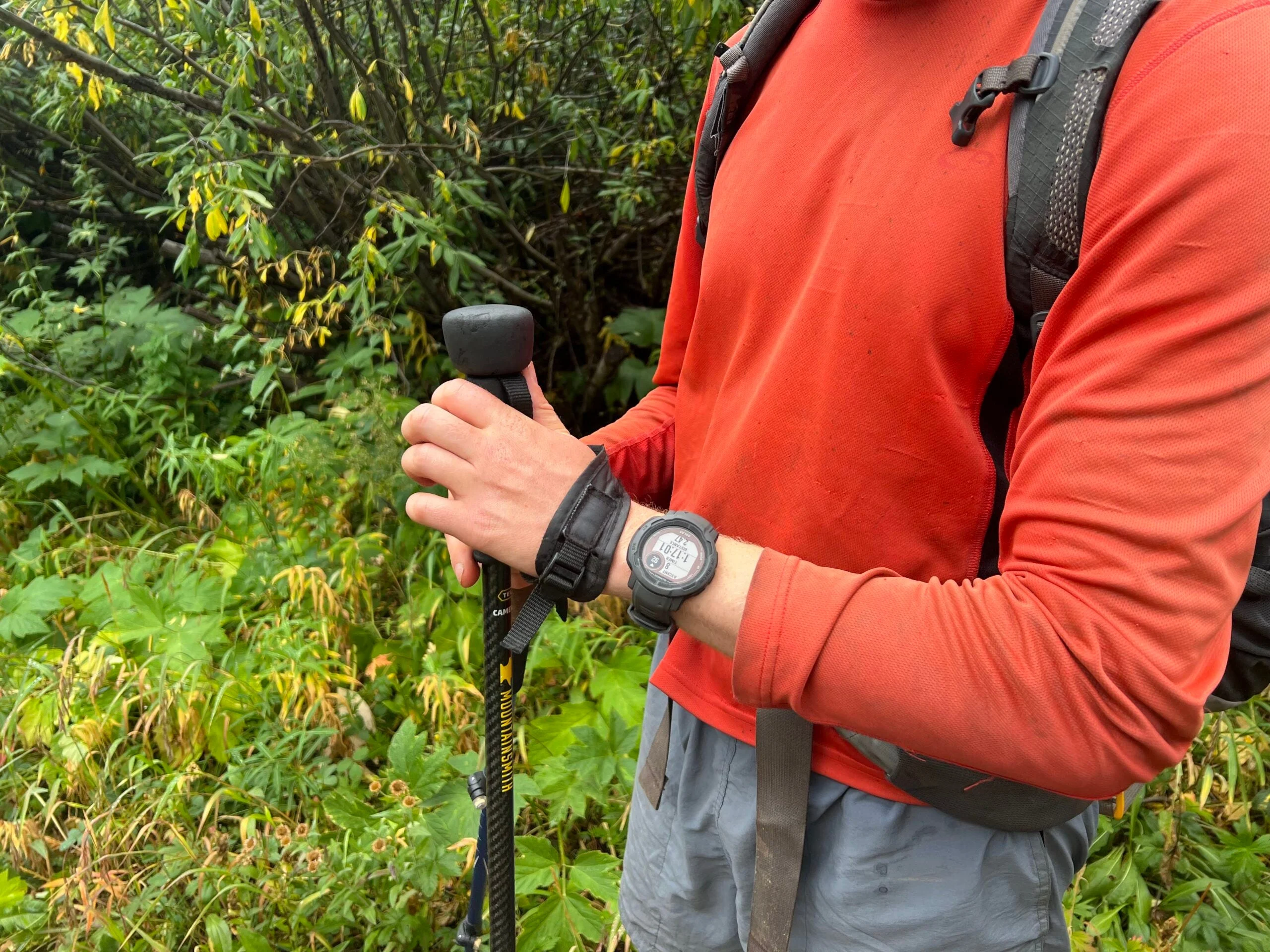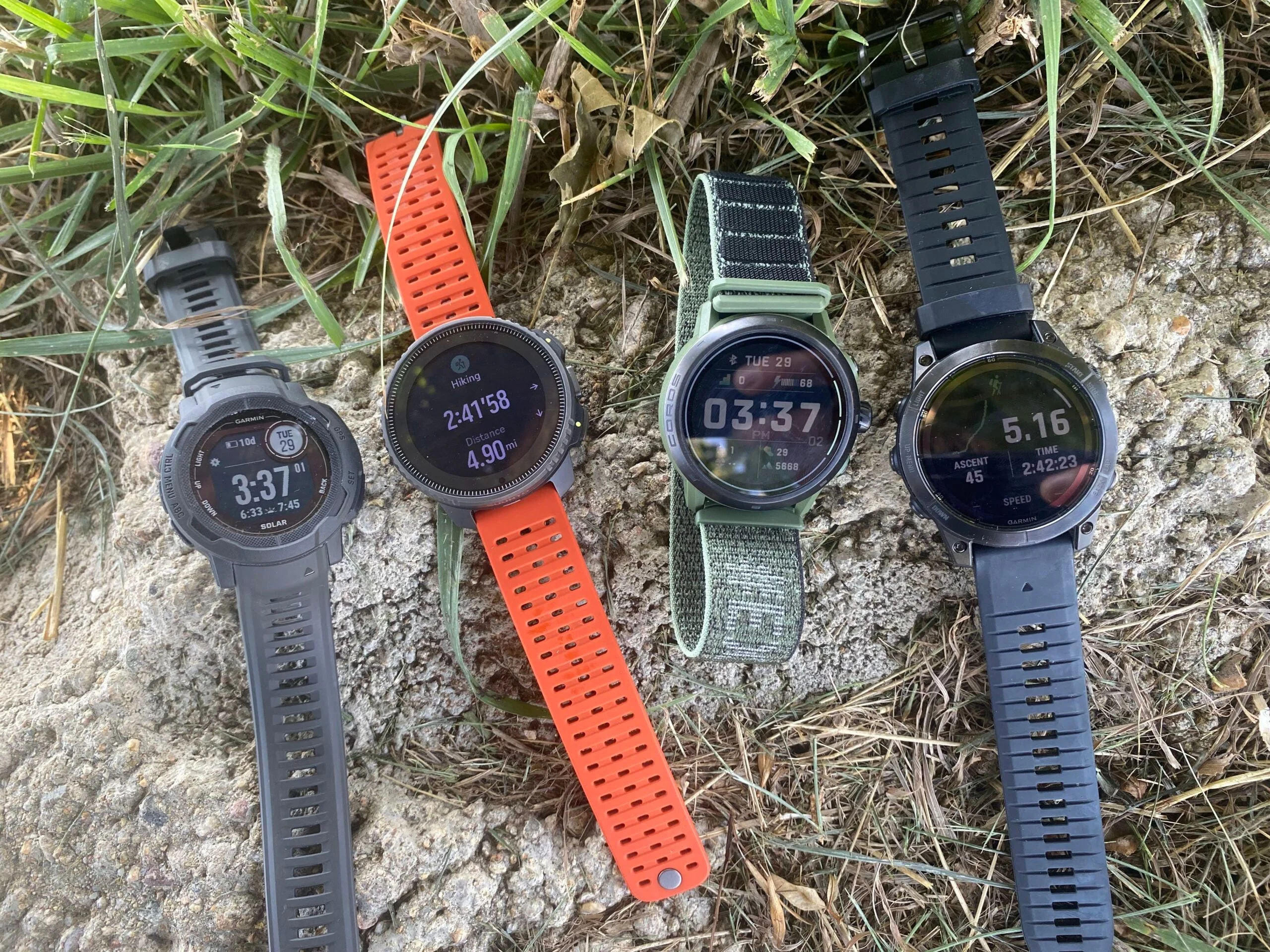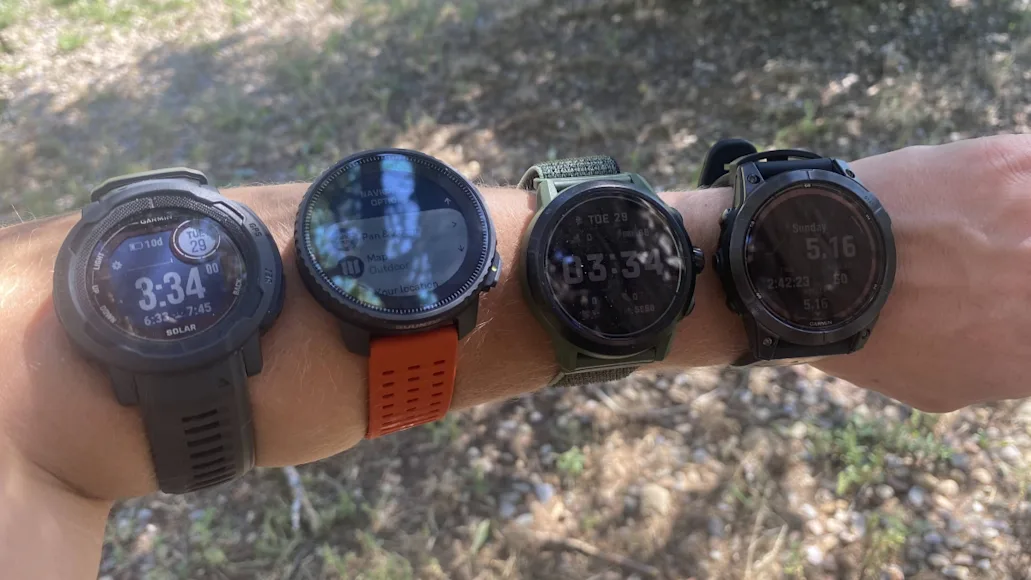We may earn revenue from the products available on this page and participate in affiliate programs. Learn more
GPS watches for hiking—like most fitness wearables—are a nearly ubiquitous piece of kit these days. While they can help you navigate off-trail terrain, they’re also be a valuable source of health data. Many can track your sleep quality, heart rate, VO2 max, and even your fatigue levels. That kind of constant comprehensive data collection can help you both optimize your performance and improve your overall health and fitness.
Of course, not all GPS watches have the same features. Some only sport bare-bones tracking capabilities, while others can feel needlessly complex. Picking the right one comes down to a careful evaluation of each product’s technical specs, as well as a little bit of soul searching. Are you hoping to replace your GPS with a smartwatch, or are you just looking for one with maps to track your Saturday morning hikes? Do you need multiple sport modes, or are you happy with just a basic setup? To help you choose, we tested top-rated models to find the best GPS watches for hiking below.
Best Overall: Garmin Fenix 7 Pro
Longest Battery Life: Suunto Vertical
Best for Backpacking: Coros Apex 2 Pro
Best for Endurance Athletes: Polar Vantage V3
Best for iPhone Users: Apple Watch Ultra 2
Best Budget: Garmin Instinct 2 Solar
Best Overall: Garmin Fenix 7 Pro
Specs
Weight: 2.2 to 2.4 oz.
Display Size: 1.2 to 1.4”
Battery Life: 46 hrs (GPS) / 14 days (regular use with solar)
Display Resolution: 260 x 260 pixels
Pros
Intuitive user interface
High-resolution display
Dozens of sport modes
Good balance of weight and features
Smaller display-size option ideal for smaller wrists
Premium maps available with a subscription
Cons
More expensive than most watches we tested
Shorter battery life than some other models
With multiple satellite systems and GPS frequency bands at its disposal, the Garmin Fenix 7 Pro consistently provided the most accurate GPS watch we tested. It has a ridiculous number of features—including more than 40 sport modes, robust backcountry mapping, and the popular “body battery” feature which tracks sleep and recovery. Yet, despite the vast number of tools and menus, the interface somehow remains easy and intuitive to navigate. Route tracking begins and ends with the tap of a button, and it’s easy to toggle between the map, time of day, and route stats while you’re in the middle of a hike.
The Fenix 7 Pro comes preloaded with maps, though we found the default topo fairly basic and of limited use in complex backcountry terrain. However, a premium subscription unlocks high-resolution topo maps, satellite maps, and other mapping layers, all of which help make backcountry navigation a breeze. Maps download relatively quickly, and the watch’s high-resolution display and touch screen make them easy to explore. Durability also impressed: while this watch is only rated up to temperatures of 113°F, it’s water resistant up to 100 meters and withstood rainstorms in the Colorado Rockies without issue. The Power Glass is resistant to scratches, and the stainless steel housing is heavy but promises a lifetime of dent-free use.
While the Garmin Fenix 7 Pro is fairly pricey, we found the best-in-class mapping, solar charging capabilities, and outstanding durability well worth the cost.
Longest Battery Life: Suunto Vertical
Specs
Weight: 2.6 oz.
Display Size: 1.4”
Battery Life: 85 hrs (GPS) / 60 days (regular use with solar)
Display Resolution: 280 x 280 pixels
Pros
Extremely high-resolution display
High-quality maps available without a subscription
Sleek, stylish design
Top notch battery life
Intuitive GPS tracking and navigation
Cons
Limited buttons make menus difficult to navigate
Maps take hours to download
Heavier than most other models we tested
Relatively expensive
The Suunto Vertical consistently ranks as one of the top-rated GPS watches for hiking—and for good reason. The broad display boasts a whopping 280 by 280 pixels, making it one of the highest-resolution watches we tested. As a result, the interface is clean, bright, and easy to read.
But the real star of the show here is the battery. Of all the watches we tested, the Suunto Vertical was the one with the longest battery life. Given regular access to direct sunlight, the watch self-charges and can go up to two months between plug-ins. And even running GPS on full-steam, it’ll last 85 hours between charges. We never had to charge it once during testing.

Of course, supersized battery life usually comes at the cost of a supersized battery. As a result, the Suunto Vertical is the heaviest watch we wore. While larger testers loved the generous display size, those with smaller wrists found it clunky and cumbersome. We were also a little disappointed by the ease of use. The minimalist button setup may make the watch look sleek and stylish, but it renders in-menu navigation unnecessarily complicated. Testers especially had trouble navigating to alternate data screens while hiking.
That said, the in-hike navigation was superb. The high-resolution maps were easy to access and explore, and accurate topo maps are available without a subscription.
Best for Backpacking: Coros Apex 2 Pro
Specs
Weight: 2.3 oz.
Display Size: 1.3”
Battery Life: 75 hrs (GPS) / 30 days (regular use)
Display Resolution: 260 x 260 pixels
Pros
Glove-friendly dial
Intuitive menu navigation
Global topography maps download in minutes
Charges in just two hours
Stylish design
Lots of sport modes to choose from
Cons
Less water-resistant than other models
The Coros Apex 2 Pro was one of the more intuitive watches we tested. It’s easy to set up, and the maps download in a matter of minutes. On top of that, it’s comfortable, durable, relatively lightweight, and boasts an impressive battery life, making it our top choice for backcountry trips.

The Apex 2 Pro comes faced in sapphire “glass,” an aluminum oxide crystal that’s much more scratch-resistant than traditional glass. The hook-and-loop style band was easy to fit and comfortable on the wrist. Unlike many of the silicone-based bands, it never tugged or pinched at our arm hair. The large dial is easy to manipulate with gloves on, and a wide working temperature range (-4°F to 122°F) makes it just as well-suited to winter camping as to desert hikes. Like the other watches we tested, the Apex 2 Pro is water-resistant (we were able to submerge it in creeks and hot springs without issue), but it’s not suitable for diving.
While we found the GPS very accurate and the mapping screens easy to navigate, the maps themselves could be better. The topos featured contour lines and significant terrain features, but smaller streams and trails remained absent from the display. However, preloaded routes and tracks were easy to create and follow, and the compass feature came in handy in densely wooded terrain.
Best for Endurance Athletes: Polar Vantage V3
Specs
Weight: 1.8 oz.
Display Size: 1.2”
Battery Life: 140 hrs (GPS) / 8 days (regular use)
Display Resolution: 240 x 240 pixels
Pros
Clean, minimalist display
Good balance of weight, features, and price
Can provide turn-by-turn directions
Lightweight design feels good on the wrist
Incredibly long battery life
Cons
Won’t work in temperatures below 14°F
Shorter battery life than other models
No topography maps
If you’re looking for a GPS watch for highly accurate workout tracking rather than backcountry navigation, look no further than the Polar Vantage V3. This lightweight watch is essentially a fitness wearable enhanced with GPS functionality. It sports robust heart rate and sleep tracking and comes with a meditation app to help manage stress. A variety of other apps help you measure and track training loads, benchmark your performance, and test your recovery.
It’s also compatible with companion apps like Strava, which can help keep you connected to your community, and Komoot, which provides turn-by-turn directions on roads and trails alike. Essentially, the entire watch is built with one goal in mind: optimizing every workout to take your hiking to the next level. Even cooler, it lasts up to eight days on a single charge.
Best for iPhone Users: Apple Watch Ultra 2
Specs
Weight: 2.2 oz.
Display Size: 1.9”
Battery Life: 36 hrs (GPS) / 60 hrs (regular use)
Display Resolution: 502 x 410 pixels
Pros
High-resolution display
Seamless integration with iPhone apps, calls, and messaging
Built-in speaker and microphone filter out noise
Glove-friendly dial
Large variety of interchangeable bands
Crash detection and emergency SOS features (cell connection required)
Cons
Shorter battery life than other models
One of the more expensive models we tested
The Apple Watch has long been known for its intuitive displays, beautiful design, and seamless integration with iMessage and Mail apps. But with the Apple Watch Ultra, it’s now truly worthy of leaving the office. The resolution is the best of all the watches we tested. It makes every screen crisp and easy to read, and it’s compatible with your favorite GPS-enabled mapping apps, including Apple Maps and Gaia GPS.
But more importantly, this new edition is as rugged as it is stylish. It boasts up to 100-meter water resistance, which means it’s dive-compatible, and an operating temperature ranging from 4°F to 131°F means you can trust it to keep up with you in a wide range of conditions. The housing is made of aerospace-grade titanium, and the face is scratch-resistant sapphire crystal.
The only big downside (other than price) is a relatively short battery life. But if you aren’t planning to spend days at a time in the backcountry, that tradeoff is worth the cutting edge fitness tracking capabilities. The Apple Watch Ultra comes with a blood oxygen sensor as well as an electrical heart sensor, and we loved it for both road and trail workouts close to home.
Best Budget: Garmin Instinct 2 Solar
Specs
Weight: 2.2 to 2.4 oz.
Display Size: 0.8 to 1.1”
Battery Life: 28 hrs (GPS) / 51 days (regular use with solar)
Display Resolution: 176 x 176 pixels
Pros
Long-lasting battery life, thanks to solar charging
Smaller display-size option ideal for smaller wrists
Relatively lightweight
Durable design doesn’t feel precious
Intuitive setup
More budget-friendly than other models
Cons
Design isn’t as sleek as other models
Smaller display can feel cluttered
The Garmin Instinct 2 Solar balances a lower price point with the same powerful features other Garmin watches are known for. It was easy for us to figure out how to use on the trail without a manual, and it pairs quickly and easily with a smartphone via bluetooth. The silicone strap was comfortable against the wrist, and the compact face never felt cumbersome.

The downside to the great price? While this is a great trail watch, it has a more technical look and isn’t as useful for everyday activities like checking phone notifications or email. That made it one of the least versatile smartwatches we tested this season. We also found the maps a bit lackluster—you can see your routes or tracks, but trails and streams don’t appear on the base map. That said, the activity tracking, body battery feature, and route tracking features were all robust. Ultimately, we were happy to trade out the other bells and whistles for a lower price point.
How We Tested GPS Watches for Hiking
GPS watches run the gamut from the relatively simplistic to the grossly over-engineered. The sweet spot lies somewhere in between: enough features that you can use your watch seamlessly for a variety of activities, but not so many that the interface is cluttered and tough to navigate. Similarly, you want a face that’s easy to read and big enough to hold a decent-size battery, but that isn’t too heavy or clunky.
A group of our backpacking and hiking experts put 10 different models to the test from top brands like Garmin, Suunto, and Coros. We narrowed them down based on their features and technical capabilities, then tested the top contenders on backcountry trails and at-home workouts alike.

After a careful comparison of their features, price, durability, and battery life, we nominated these six as the year’s best GPS watches for hiking.
What To Consider When Choosing a GPS Watch for Hiking
Features
Most smartwatches come with a bevy of features and sport modes, but few are equipped to track more niche sports like racquetball or indoor bouldering. If you have active hobbies aside from hiking, be sure to consider these. Also think about your everyday activities. Do you want to be able to take calls or read emails on your watch? Track your sleep and post-workout recovery? Get turn-by-turn directions? Link up to your favorite apps? Make a list of your must-have features, and another list of your dream features. Keep these in mind as you shop.
Size and Weight
Weight and display size are also worth considering. If you have small wrists, a watch with a display much bigger than 1.4 inches may feel cumbersome. Likewise, anything more than about 2.2 ounces will be noticeable on your wrist. That said, size can be a worthy tradeoff if you’re headed deep into the backcountry and need a model with plenty of space for a bigger battery or solar array.
Durability
If you’re shelling out several hundred bucks for a piece of hiking gear you hope to use in rugged environments, you’d better make sure it’s durable. Watches with titanium or stainless steel housings tend to be more rugged, though most plastic cases can also take a beating. The weak point of most smartwatches is the face. Look for displays made of sapphire crystal, a transparent material made of crystalized aluminum oxide. It’s much harder than glass (and also more expensive). Other types of toughened glass, like Gorilla Glass or the ceramic-hardened glass used in iPhones, are very strong, though less scratch-resistant than sapphire.
FAQs
Q: Which watch has the most accurate GPS?
Most GPS watches come with a little bit of variability, especially in tricky terrain like dense forests or canyon country. Most GPS units—including handheld GPS devices—tend to be off by about 1 to 2% of the actual distance. That said, some models do tend to be more accurate than others. Watches that use multi-band satellites and multi-frequency positioning—like the Garmin Fenix 7 or Coros Apex 2 Pro—tend to have better accuracy than those that connect to only one satellite system.
If you need top-notch accuracy but don’t want to shell out for one of the pricier GPS watches, it’s worth considering a hand-held GPS unit. A number of top-rated hunting GPS units, for example, connect to multiple satellite networks but cost less than high-end smartwatches.
Q: How long do GPS watches for hiking last?
Most GPS watches come with rechargeable batteries, which can last anywhere from 12 hours to 60 days on a single charge, depending on what features you’re using. Second-by-second tracking and GPS navigation will suck up more battery life, while basic watch functions use very little energy at all.
You can typically get two to five years of life out of most GPS watches for hiking. That will vary widely depending on how often you use your watch and what kinds of conditions you subject it to.
Q: What is the best GPS watch for mountain climbing?
The best GPS watch for mountain climbing is one that has reliable mileage and elevation tracking as well as reliable off-trail navigation. Of the watches we tested, the Suunto Vertical and Coros Apex 2 Pro scored the highest marks for navigational ease and backcountry mapping. But if you’re more interested in tracking your fitness gains, the Garmin Fenix 7 Pro is a great choice.
Final Thoughts
The best GPS watches for hiking are those that provide a thoughtful balance between weight, features, battery life, and ease of use. If you’re searching for the perfect outdoor smartwatch, be sure to consider these top models. Of all the ones we tested, we recommend the Garmin Fenix 7 Pro. Not only did it provide the best GPS accuracy in woodland terrain, but it also provides easy-to-parse graphs that show your heart rate, elevation profile, and other stats.
Why Trust Us
For more than 125 years, Field & Stream has been providing readers with honest and authentic coverage of outdoor gear. Our writers and editors eat, sleep, and breathe the outdoors, and that passion comes through in our product reviews. You can count on F&S to keep you up to date on the best new gear. And when we write about a product—whether it’s a bass lure or a backpack—we cover the good and the bad, so you know exactly what to expect before you decide to make a purchase.








